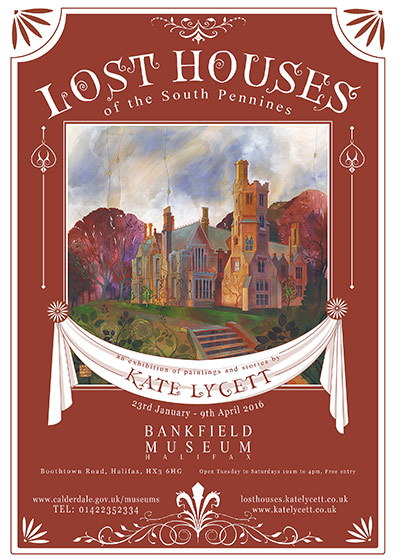Local History Society Report
Lost Houses of the South Pennines
Speaker:Kate Lycett
Tuesday, 15 January 2019
There was standing room only when artist Kate Lycett came to speak to Hebden Bridge Local History Society about the stories behind her hugely successful paintings of the Lost Houses of the South Pennines. Kate traced her fascination back to a ‘crinkle crankle’ wall of her childhood, when her imagination created a fantasy house which she was sure must exist out of sight.
As an artist settled in Hebden Bridge she found that many grand local houses had disappeared almost without trace, and set about searching the archives for documents and photographs that would give her enough detail to create paintings which celebrated their individual styles and moods.

Many of the houses she chose were built in the nineteenth century for industrialists who wanted a residence to reflect their wealth and success. For example the Foster family of Black Dyke Mills built Harrowins and Littlemoor Castle at Queensbury, the latter outdoing the former in extravagance and luxury, but both falling into disrepair and all but disappearing in the twentieth century.
Drawings in the archive revealed a feast of decorative detail, though it isn’t clear that all these were incorporated in the final building. All that remains are the garden steps in Littlemoor Park which feature in Kate’s painting.
Another house that came and went in a burst of extravagance was Castle Carr, unloved in its isolated splendour above Luddenden. Its story is marked with disputes, court cases and accidental deaths, but the archives reveal a very grand house, with spectacular water gardens and powerful fountain to impress visitors. It was rarely occupied and in the second world war its location made it ideal for the storage of TNT. Kate said that she wanted to capture some of the menace of the place in her painting.
Another industrialist who made his mark with a spectacular house was Sir Isaac Holden, whose Oakworth House near Keighley might have been the most luxurious of all. It was in the Italianate style and gloried in silver fixtures, pale marble and white plaster decorative details. As an inventor, Sir Isaac also wanted to equip his house with cutting edge utilities – gas, electricity, heating and air conditioning. There was a Turkish baths and forty glass houses, noted as the finest in England, growing exotic fruit. Sir Isaac Holden lived till his nineties, but when he died at the end of the century, there was no buyer for the house, which fell into disrepair and finally burnt down in 1909. What remains is in Holden Park – a portico, some stone paths and concrete grottos.
While many of the lost houses which Kate has researched and painted had a short lived blaze of glory in the nineteenth century, some were much more long lived. These were the homes of the successful industrialists of an earlier era – the rich clothiers who made their fortunes and built their houses in the Halifax area.
High Sunderland was one such house, extended and stone clad in the seventeenth century and decorated with stone carvings, statues, gargoyles and griffins. Like many such houses it was subdivided over the years, and eventually abandoned. Kate was fascinated by the probable link with Emily Bronte’s Wuthering Heights – the description of that house, especially the ‘gargoyles and shameless boys’ over the front porch uncannily matches the photographic evidence. There is even a ghost story with a tapping hand that echoes the experience of Bronte’s narrator when he first sleeps at Wuthering Heights. After its demolition in the mid twentieth century, some of the decorative stones were donated to Shibden Hall, where they lie rather neglected and anonymous.
Kate also had an interesting search for the stone remains of another 17th century house, Norland Hall, which was demolished after being struck by lightning in 1912. It looked set for a brighter future when the fantastically wealthy American publisher William Randolph Hearst decided that he wanted a house built in the style of an English manor house, and arranged for the stones of Norland Hall to be shipped to California in 812 crates. In the end, it seems he changed his mind and the crates were abandoned on the quayside while he went ahead with a Spanish style house. Kate discovered that some of the stones had been incorporated into a Presbyterian church, and an inquiry on social media rather wonderfully brought her photographs of a date stone, stone carvings and a plaque recording the origins of the stones.
Those who have seen Kate’s paintings, or the prints in the book that she produced, will have been struck by the glowing colours and the fairytale atmosphere they evoke. The combination of historical research, personal stories, exploring the landscape and artistic imagination has produced something quite magical which it was fascinating to hear about.
The next meeting of Hebden Bridge Local History Society will be at 7.30 on Wednesday 23rd January at Hebden Bridge Methodist Church. David Garside will be exploring the Milestones and Waymarkers of the South Pennines. All welcome.
With thanks to Sheila Graham for this report
Details of all the Society’s activities can be found on the website and you can also follow them on their Facebook page.
See also
The first few episodes of Gentleman Jack (screenplay: Sally Wainwright) were inspired by two books written by local historian Jill Liddington, including Nature's Domain published by Pennine Pens


